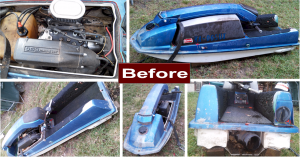Post Created October 2014.
 Hi, this is my first personal water craft, a 1988 Kawasaki Jet Ski. Picked it up for $25. I plan a total restoration with everything tended to. I quickly learned that working on PWC’s is NOTHING like boats! You need lots of special tools and lots of patience. You would think that such a small craft would be easy but think again! For example, 3 things right off: First, the hull is Sheet Molded Compound “SMC”, not fiberglass, so you must use epoxy resin not polyester. Second, the motor is about the same size as a typical powerhead on a boat more, but that’s where the similarities end! Forget about rebuilding the crankshaft yourself. Third, the jet drive requires lots of knowledge and special tools. I will call this a “learning experience” and it has already been at least partially rewarding in that I successfully completely disassembled the motor. In the end I will hopefully gain knowledge to help other Jet Ski owners.
Hi, this is my first personal water craft, a 1988 Kawasaki Jet Ski. Picked it up for $25. I plan a total restoration with everything tended to. I quickly learned that working on PWC’s is NOTHING like boats! You need lots of special tools and lots of patience. You would think that such a small craft would be easy but think again! For example, 3 things right off: First, the hull is Sheet Molded Compound “SMC”, not fiberglass, so you must use epoxy resin not polyester. Second, the motor is about the same size as a typical powerhead on a boat more, but that’s where the similarities end! Forget about rebuilding the crankshaft yourself. Third, the jet drive requires lots of knowledge and special tools. I will call this a “learning experience” and it has already been at least partially rewarding in that I successfully completely disassembled the motor. In the end I will hopefully gain knowledge to help other Jet Ski owners.
The crankshaft is bad, you can’t even turn the front main bearing. I will shift focus back to the body while I hunt for a new crank (or a suitable rebuilder) this winter. Note to self: Approach with caution, the motor can explode with an improperly aligned crankshaft, because of runout.
Take a good look at this photo, you will not believe your eyes when I’m finished!
